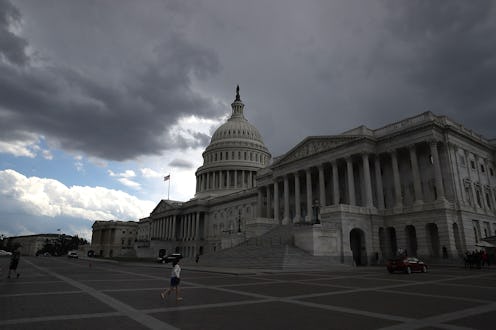News
How Congress' Dress Code Unfairly Targets Women

By their very nature, dress codes affect women differently. The dress codes enforced in Congress that disproportionately target women bear no exception to this rule. According to a report from CBS News, a female reporter who was barred from entering the the Speaker's Lobby because her dress was sleeveless ripped pages from her notebook and stuffed them into the shoulders of her outfit in an attempt to circumvent the dress code. She was still turned away.
While technically, there is no written dress code banning sleeveless dresses from the House, the interpretation of appropriate attire is left up to House Speaker Paul Ryan. (These restrictions aren't currently enforced on the Senate side.) On June 23, He reminded lawmakers that casual attire, however interpreted, was not accepted in Congress. He said, "Members should wear appropriate business attire during all sittings of the House however brief their appearance on the floor may be."
Surely the enforcement of professional attire is in complete keeping with the polished ideals of Congress. However, it's worth noting that a House dress code banning sleeveless dresses is difficult for female politicians and reporters to uphold in warmer months, when much of the business-appropriate dress attire for women is sleeveless.
However, the Speaker's Lobby, which is located in front of the House Chamber, has been enforcing these interpretative rules for journalists. For men, the theme has been suit jackets and ties. For women, no sleeveless dresses, blouses, open-toed shoes, or sneakers.
While this may sound reasonable enough, the dress code requirements of women, versus what formal wear is created for women creates a Catch-22 of sorts. The disconnect between "appropriate business attire" and the often sleeveless formal wear sold to women presents yet another hoop for women to jump through when participating in politics.
While enforcement of the dress code appears more stringent in the summertime, this rule has been nebulously at play for a while. In early May, when the House first voted to pass the GOP health care bill, Haley Byrd, a congressional reporter for the Independent Journal Review told CBS News she was kicked out of the Speaker's Lobby due to her sleeveless dress.
"When I was kicked out that day, I was just trying to pass through the area to reach another hallway, but I was told I was violating the rules. They offered to find a sweater for me to put on, so it wasn't some tyrannical end of free press, but I opted to just go around instead. But recently they've been cracking down on the code, like with open-toed shoes."
On the contrary, men have been told to put on ties when approaching Congress. Back in 2013, a former reporter Jacob Fischler posted a photo of himself on Twitter wearing a tie he dubbed the "Tie Of Shame."
At first glance, there could easily be parallels drawn between asking a female reporter to wear a cardigan over her dress, and asking a male reporter to add a tie to his outfit.
However, when we consider the realities, in one situation, a man is being offered a tie to further dress up his look. A tie will invariably make the dress shirt look more formal.
On the other hand, a woman in a formal dress is being asked to cover up her arms with a cardigan. There is a distinct difference between a piece that adds formality to an outfit, and forcing a reporter to cover up their sleeveless dress in order to obscure their body. Herein lies the largest difference, the act of covering up a body, and the act of dressing up an outfit.
Certainly, it makes sense to dress appropriately when speaking in, or reporting on Congress in any capacity. But when standards for what constitutes "appropriate" for women continue to be different from men, the House's enforcement of dress codes are yet another example of how such rules impact women differently.